COFFEE GEAR FOR YOUR EVERYDAY OUTDOORS OFFICE ADVENTURE HOME CAR
Free Shipping On Orders $45+
Home » Coffee Blog » Campfire Coffee: Embracing the Art of Outdoor Brewing
Campfire Coffee: Embracing the Art of Outdoor Brewing
Picture yourself waking up to the crackling sound of a campfire, surrounded by nature’s serene beauty. As you breathe in the fresh morning air, your senses awaken to the inviting aroma of freshly brewed campfire coffee.
In this blog, we will delve into the art of outdoor coffee brewing, specifically focusing on three popular methods: pour-over, percolator, and French press. Whether you’re a seasoned camper or new to the camping experience, we will guide you through each brewing technique, providing tips, step-by-step instructions, and insights into different campfire coffee styles. Get ready to elevate your camping adventures with campfire coffee’s rich, flavorful embrace.
Campfire Coffee: Embracing the Art of Outdoor Brewing
Picture yourself waking up to the crackling sound of a campfire, surrounded by nature’s serene beauty. As you breathe in the fresh morning air, your senses awaken to the inviting aroma of freshly brewed campfire coffee.
In this blog, we will delve into the art of outdoor coffee brewing, specifically focusing on three popular methods: pour-over, percolator, and French press. Whether you’re a seasoned camper or new to the camping experience, we will guide you through each brewing technique, providing tips, step-by-step instructions, and insights into different campfire coffee styles. Get ready to elevate your camping adventures with campfire coffee’s rich, flavorful embrace.
The History and Rituals of Campfire Coffee
Campfire coffee holds a special place in the hearts of outdoor enthusiasts, offering a rich and robust cup of warmth that accompanies early mornings and evenings spent in nature. Let’s delve into the intriguing history and captivating rituals surrounding campfire coffee.
The Origin of Campfire Coffee:
The roots of campfire coffee can be traced back to the early days of outdoor exploration and survival. Coffee itself has a long history, originating from Ethiopia in the 9th century. As the art of brewing coffee spread across the world, so did the practice of making coffee over an open flame.
People had to devise ingenious methods to prepare coffee in the wilderness, where resources were scarce. Campfire coffee emerged as a solution, allowing travelers, adventurers, and campers to enjoy their favorite beverage while away from the comforts of civilization.
Traditional Methods of Brewing Coffee over a Campfire:
- Cowboy Coffee: One of the most iconic and time-honored methods, cowboy coffee involves simply boiling coffee grounds in a pot of water over the campfire. After the coffee reaches a rolling boil, it is left to steep before being poured carefully, ensuring the grounds settle at the bottom.
Percolator Brewing: Another traditional method uses a campfire percolator, consisting of a pot with a central tube and a filter basket. Water in the pot is heated, causing it to rise through the tube and percolate over the coffee grounds, creating a strong and flavorful brew
- Improvised Brewing: In resource-limited situations, campers have employed creative techniques such as using makeshift filters, fabric pouches, or even socks to strain coffee grounds, ensuring a reasonably smooth cup of campfire coffee. (I’ve done the sock method… Not Bad?)
Cultural Rituals Associated with Campfire Coffee:
Campfire coffee holds a sense of tradition and camaraderie, fostering unique rituals and practices among campers. Some cultural aspects and rituals related to campfire coffee include:
- The Morning Ritual: In many camping communities, the act of brewing and enjoying campfire coffee in the morning becomes a sacred ritual. It serves as a moment to gather around the fire, share stories, and savor the tranquility of the natural surroundings.
- Passing the Brew: Campfire coffee often becomes a communal experience. Passing around the pot or sharing a cup with fellow campers fosters a sense of community and bonding, as everyone partakes in the same elixir that fuels their adventures.
- Appreciating Simplicity: Campfire coffee celebrates the brewing process’s simplicity and the final product’s enjoyment. It reminds us to embrace the ruggedness of the outdoors, disconnect from the modern world, and relish nature’s uncomplicated pleasures.
The history and rituals of camp coffee have inspired BruTrek® to become what it is today. The rituals of sharing stories, appreciating simplicity and fostering community have built our appreciation of the outdoors, inspiring our desire to get more people outdoors.
The history of campfire coffee stretches back through time, intertwined with the journeys of explorers and adventurers seeking solace and sustenance in the wilderness. Traditional brewing methods and the cultural rituals surrounding campfire coffee evoke a sense of nostalgia and connection to nature. So, the next time you gather around a campfire, let the rich aroma and ritual of campfire coffee transport you to a simpler time, where the crackling flames and the perfect cup of coffee are all you need to savor the moment. And hopefully, you can use a BruTrek® Travel French Press instead of a traditional percolator (or sock).
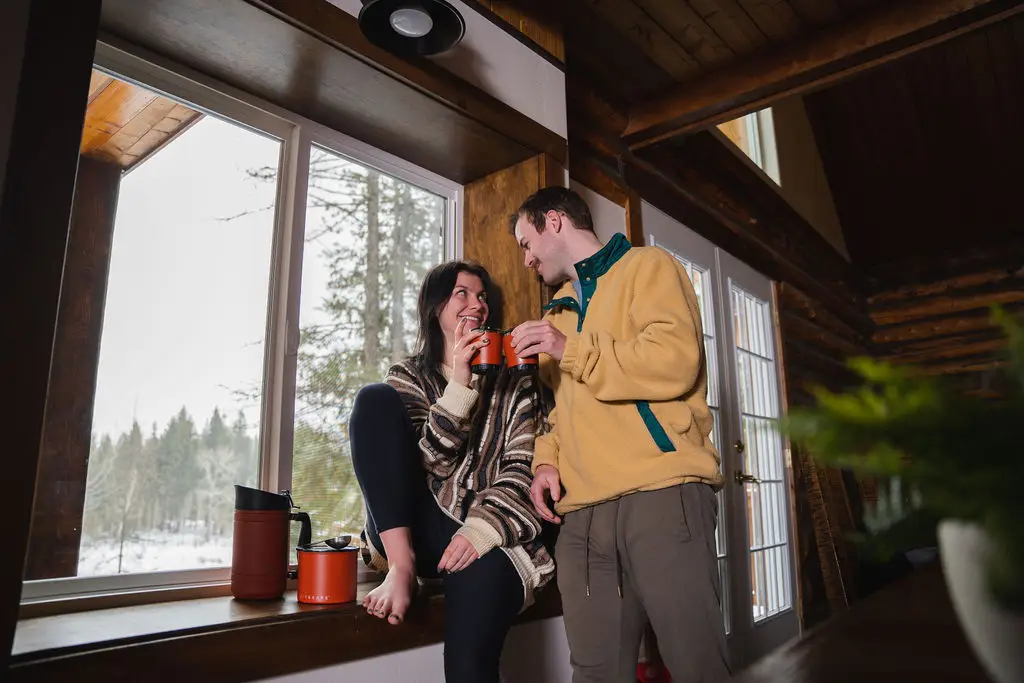
Essential Equipment for Brewing Campfire Coffee
Brewing coffee outdoors requires a few key tools to ensure a smooth and enjoyable experience. Whether you’re a seasoned camper or new to the world of outdoor brewing, here is the must-have equipment for brewing campfire coffee:
Or read this blog of how to make the best Coffee Outdoors
1. Campfire Coffee Brewing Equipment
Heating Source
Coffee Brewing Device
Coffee Grinder
Heat-Resistant Coffee Mug
Kettle or Pot
Coffee Storage
2. Suitable Coffee Brewing Methods for Campfire
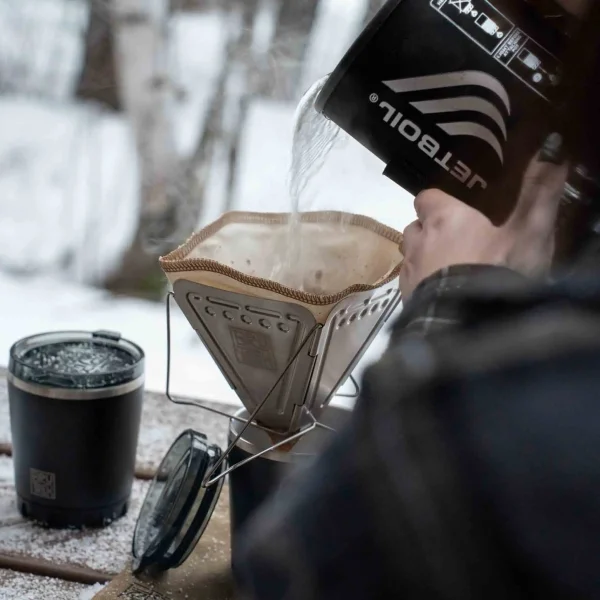
a) Pour-Over Brewing
Pour-over coffee is popular for its simplicity and clean taste. It requires a pour-over dripper (such as the BruTrek® Collapsible Pour Over *watch BackpackingTV’s review of BEST CAMP COFFEE*), paper filters, and a heatproof vessel to catch the brewed coffee.
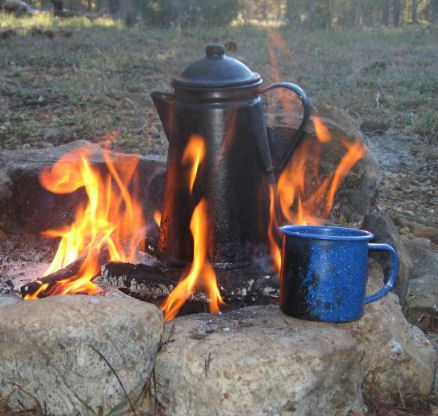
b) Percolator Brewing
The classic percolator method is well-suited for campfire brewing. A campfire percolator includes a pot, a central tube, a filter basket, and a lid. It allows the water to percolate over the coffee grounds, producing a strong and flavorful cup.
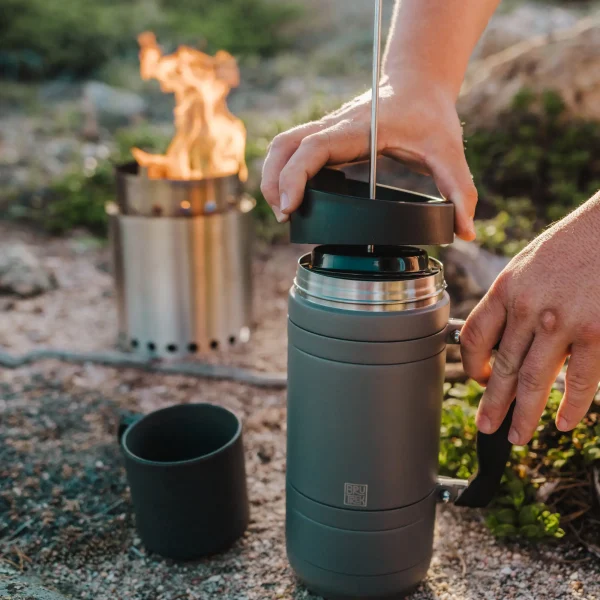
c) French Press Brewing
The French press method is immersive and produces a full-bodied brew. You’ll need a French press with a heatproof glass or stainless-steel construction and a plunger mechanism.
3. Choosing the Right Coffee Grinder for Camping:
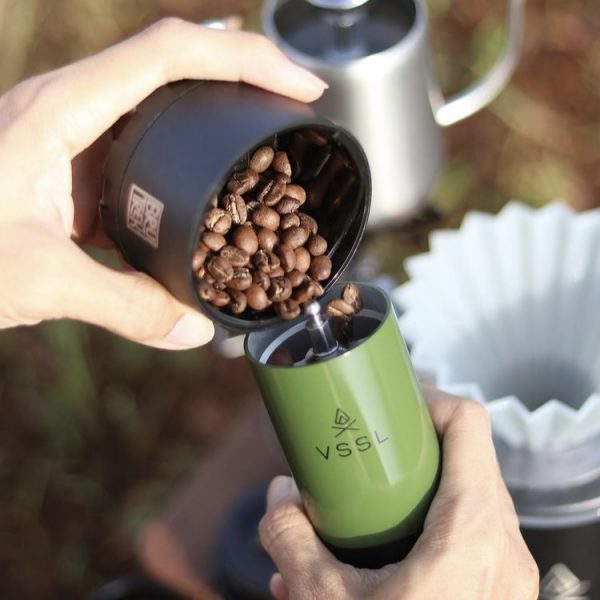
- a) Manual Coffee Grinder: A manual coffee grinder is often the most practical camping option. Look for a compact, lightweight, and durable grinder that can withstand outdoor conditions. Stainless Steel burr grinders are known for their consistent grind size and durability.
- b) Size and Portability: Consider the size and weight of the coffee grinder, as it should be compact enough to fit in your camping gear without taking up excessive space or adding unnecessary weight.
- c) Adjustable Grind Settings: Choose a grinder that offers adjustable grind settings, allowing you to fine-tune the grind size based on your preferred brewing method.
- d) Durability and Easy Maintenance: Opt for a coffee grinder made from sturdy materials like stainless steel or aluminum. It should be easy to clean and maintain during your camping trips.
- e) Ergonomics and Grip: Ensure the grinder has a comfortable grip and ergonomic design, as you'll manually grind the coffee beans.
Equipped with the right tools, brewing campfire coffee becomes a delightful and satisfying experience. Whether you prefer pour-over, percolator, or French press brewing, having essential equipment such as a heat source, brewing device, coffee grinder, and heat-resistant mug will ensure you can savor the flavors of freshly brewed coffee amidst the beauty of nature. So, pack your gear, prepare your favorite coffee beans, and embark on a memorable camping adventure complete with the perfect cup of campfire coffee.
Brewing Techniques for Delicious Campfire Coffee
Brewing the perfect cup of campfire coffee requires a combination of technique, precision, and a touch of creativity. Whether you’re using a pour-over dripper, a percolator, or a French press, here are the steps and tips to help you achieve a delicious brew over a campfire:
1. Steps to Brew Perfect Campfire Coffee:
- a) Heat the Water: Begin by heating the appropriate amount of water in a kettle or pot over the campfire. Aim for water temperature below boiling, around 195-205°F (90-96°C) for optimal extraction.
- b) Grind the Coffee: Grind your coffee beans just before brewing to preserve freshness. Use a consistent grind size appropriate for your brewing method. A medium-fine to medium grind works well for pour-over, while percolators and French presses benefit from a coarser grind.
- c) Add Coffee and Water: Place the appropriate amount of coffee grounds into your brewing device, depending on your brewing method. Pour a small amount of hot water over the coffee grounds to saturate them evenly, allowing them to “bloom” and release their flavors and aromas. Then, gradually pour the remaining water in a controlled manner.
- d) Brew Time: Follow the recommended brewing time for your chosen method. Typically, pour-over coffee takes around 2-3 minutes, percolators brew for 7-10 minutes, while French press coffee requires 4-5 minutes of steeping time.
- e) Serve and Enjoy: Once the brewing time is complete, remove the brewing device from the heat source, and pour the coffee into your heat-resistant mug. Take a moment to appreciate the aroma before savoring each sip of your perfectly brewed campfire coffee.
2. Achieving the Right Coffee-to-Water Ratio without Measuring Tools:
Measuring tools might not always be readily available while camping. However, there are alternative ways to achieve a balanced coffee-to-water ratio:
- a) The Finger Method: A simple method involves using your finger to estimate the amount of coffee and water. Start by placing coffee grounds in your brewing device until they cover the bottom to a depth similar to the width of your finger. Then, add water until it reaches a level equivalent to the height of two fingers above the coffee grounds.
- b) Countertop Measurements: If you have a spare cup or mug with known measurements, you can use it as a makeshift measuring tool. For example, you can estimate a tablespoon of coffee grounds by using a standard teaspoon and counting the number of teaspoons needed to fill a tablespoon. Similarly, you can count the number of cups or ounces in your container to gauge the water volume.
Remember, these methods provide approximate measurements, so adjusting the ratios based on personal taste preferences and the strength of coffee you desire is essential.
3. Tips for Controlling the Brewing Temperature over a Campfire:
- a) Adjusting the Heat: Controlling the brewing temperature while using a campfire can be challenging, but you can employ a few techniques. If your campfire has adjustable flames, regulate the heat by increasing or decreasing the distance between the brewing device and the flames. Alternatively, you can partially cover the pot or kettle with a lid to trap heat and achieve a more consistent temperature.
- b) Preheating the Brewing Device: Before adding the coffee grounds and water, preheat your brewing device by pouring a small amount of hot water into it and letting it sit for a minute or two. This helps maintain a more stable brewing temperature, ensuring optimal extraction.
- c) Monitoring the Water Temperature: While you may not have a thermometer on hand, you can observe visual cues to gauge the water temperature. When heating the water, watch for small bubbles in the water, moisture condensing on the outside heating vessel, and eventually turning into steam with larger bubbles.
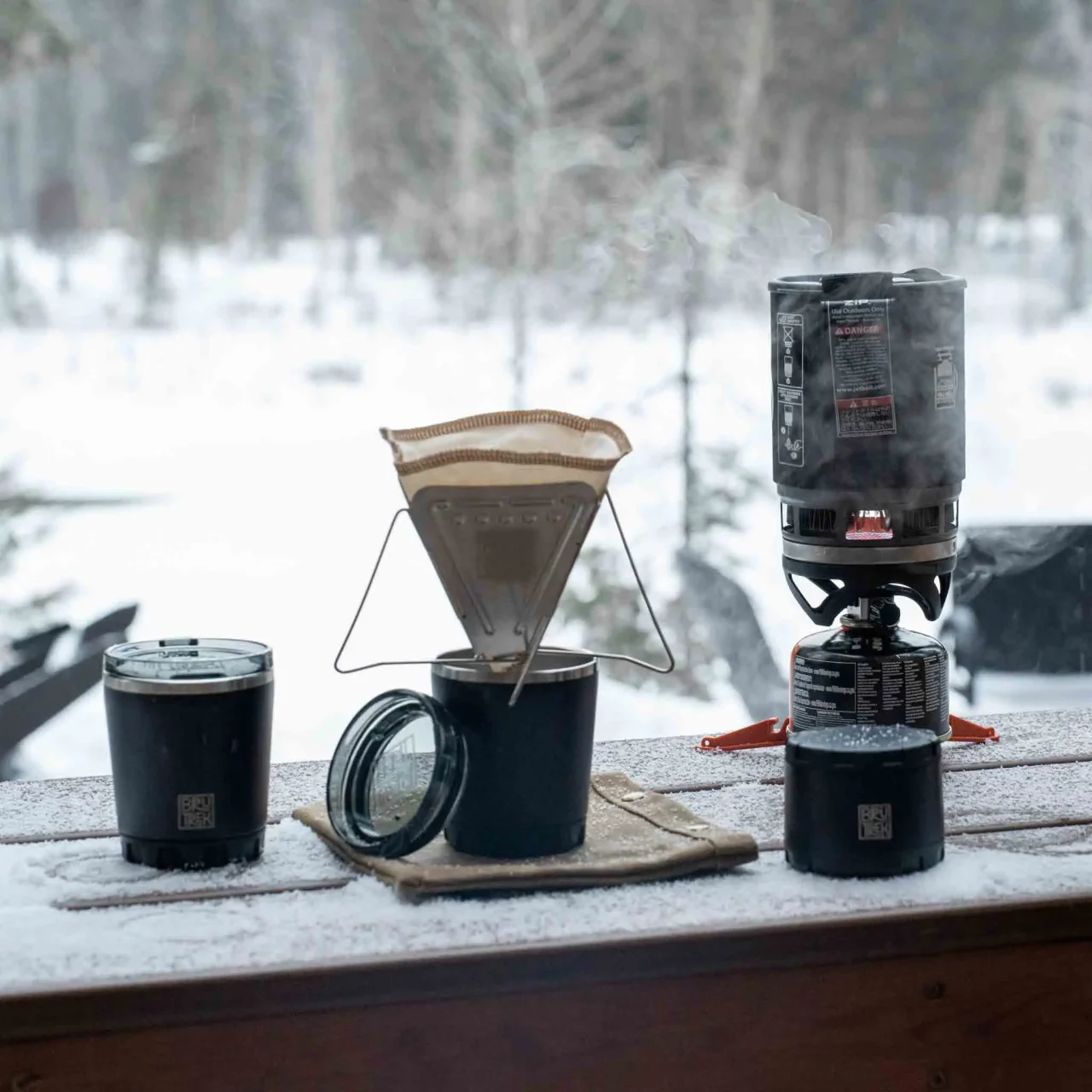
Campfire Coffee Brewing Methods:
I. The Art of Pour-Over Campfire Coffee
Pour-over coffee is a method celebrated for its simplicity and ability to produce a clean and flavorful cup. Its popularity among campers stems from its minimalistic design, which requires only a few essential tools and delivers excellent results. The beauty of pour-over coffee lies in the balance it strikes between control and ease of brewing.
Pour-over brewing allows you to extract the nuanced flavors of your coffee beans by controlling factors like water flow rate, temperature, and timing. It provides a hands-on experience that lets you appreciate the craftsmanship of brewing while enjoying the natural surroundings of your campsite. The slow and deliberate pour creates a sensory ritual that enhances the overall coffee-drinking experience.
Pour-over coffee has gained popularity among campers due to its simplicity and versatility. The equipment required for pour-over brewing is lightweight and portable, making it easy to carry on camping trips. It also allows campers to control the brewing process, ensuring a quality cup of coffee even in remote locations. The pour-over method is adaptable to different grind sizes and coffee varieties, making it suitable for various preferences and camping situations.
Essential Equipment for Pour-Over Brewing:
To brew delicious pour-over coffee while camping, you’ll need the following essential equipment:
1. Pour-Over Device:
Various pour-over devices are available, and we may be bias butttttt we like our Collapsible Pour Over by BruTrek®.
2. Filters:
Invest in high-quality paper filters or reusable metal filters designed for your specific pour-over device. Filters help ensure a clean and sediment-free cup of coffee. (With the purchase of the Collapsible Pour Over by BruTrek®, a reusable filter from Coffee Sock comes with the kit!)
3. Coffee Grinder:
4. Kettle or Pot
5. Heat-Resistant Mug or Travel Cup
6. Coffee Storage
Check out the Backpacking Coffee Bundle if you’d like an all-in-one kit.
Step-by-Step Guide to Pour-Over Campfire Coffee:
1. Prepare Your Campsite and Fire Setup:
Ensure you have a stable surface to place your brewing equipment. Set up your campfire or camping stove, ensuring you have a controlled flame to heat your water.
2. Achieving the Ideal Water Temperature:
Heat the water in your kettle or pot over the campfire until it reaches the desired temperature, ideally between 195-205°F (90-96°C).
3. Mastering the Pour-Over Technique for a Delicious Cup:
Place a filter in your pour-over device, rinse it with hot water to eliminate any paper taste, and preheat the brewing device. Discard the rinse water. Add the desired amount of coffee grounds to the filter, ensuring a level bed of coffee.
4. Start the Pour-Over Process:
Begin pouring hot water slowly and evenly over the coffee grounds, starting from the center and moving outward in a spiral motion. Aim for an even saturation of the coffee grounds without flooding the filter.
5. Controlling the Flow and Timing:
Maintain a steady and controlled pour, adjusting the flow rate to achieve a total brew time of around 2-3 minutes. Experiment with different pouring techniques, such as pulsing or continuous pouring, to find the method that works best for you.
6. Serve and Enjoy:
Remove the pour-over device from the mug or carafe once the coffee has finished dripping through the filter. Give the coffee a gentle stir to ensure even extraction, and enjoy the aromatic flavors of your freshly brewed pour-over campfire coffee.
Want a more in-depth guide to pour-over coffee? Read This!
Tips and Troubleshooting for Pour-Over Coffee:
If your coffee tastes weak or over-extracted, adjust the grind size accordingly. Finer grinds increase extraction speed, while coarser grinds slow it down. Experiment with different grind sizes to find the right balance.
Factors like wind, uneven surfaces, and limited resources can present challenges in outdoor settings. Look for a sheltered spot to minimize the impact of wind, stabilize your brewing setup, and adapt your technique as needed to ensure a successful pour-over brew.
Consider experimenting with different additives to enhance the flavor of your pour-over coffee. Some popular options include spices like cinnamon or cardamom, a dash of cocoa powder, or a splash of vanilla extract. These additions can complement the natural flavors of the coffee and add an exciting twist to your campfire brewing experience.
By embracing the simplicity and artistry of pour-over brewing, you can enjoy a delicious and customized cup of coffee while immersing yourself in the serenity of nature. Whether you’re a seasoned pour-over enthusiast or new to this brewing method, brewing pour-over coffee over a campfire allows you to connect with the brewing process and create a memorable coffee experience amidst the great outdoors.

Campfire Coffee Brewing Methods:
II. Exploring the Percolator Method
Percolator coffee holds a classic charm that harkens back to simpler times and evokes a sense of nostalgia. The percolator brewing process involves hot water circulation through coffee grounds, resulting in a robust and flavorful cup of coffee. Let’s delve into the world of percolator coffee and explore how to brew perfect campfire coffee using this method.
The percolator is a coffee brewing device consisting of a pot, a central tube, and a perforated basket that holds the coffee grounds. As the water heats up in the bottom chamber, steam pressure forces the hot water up through the tube and over the coffee grounds. The water then trickles down through the grounds, creating a continuous brewing cycle. This process extracts the coffee’s flavors and produces a rich, full-bodied brew.
Choosing the Right Percolator for Camping:
When selecting a percolator for camping, consider the following factors:
1. Material and Durability:
Look for percolators made of stainless steel or other durable materials suitable for outdoor use. These materials withstand the rigors of camping and are easy to clean.
2. Size and Capacity:
Consider the number of people you’ll be brewing coffee for. Choose a percolator with an appropriate size and capacity to meet your needs. Smaller sizes are ideal for solo or small-group camping, while larger ones are suitable for larger gatherings.
3. Portability:
Opt for a lightweight and compact percolator that is easy to pack and carry. Collapsible handles and detachable parts can make storage and transportation more convenient.
Brewing Perfect Campfire Coffee with a Percolator:
1. Preparing the Percolator and Coffee Grounds:
Assemble your percolator according to the manufacturer’s instructions. Add the desired amount of water to the bottom chamber, ensuring it doesn’t exceed the maximum fill line. Place the perforated basket on top and fill it with coarsely ground coffee. Use approximately one tablespoon of coffee grounds per 6 ounces of water, adjusting to your preferred strength.
2. Controlling the Percolation Process for Desired Strength:
Position the percolator on the campfire or camping stove over medium heat. As the water heats up, the percolation process begins. Pay attention to the percolator’s glass or transparent knob on the lid. Once you start seeing a steady stream of coffee flowing into the knob, reduce the heat slightly to maintain a gentle percolation.
3. Extracting the Coffee and Avoiding Common Pitfalls:
Brewing time varies depending on the desired strength and the size of the percolator. Generally, aim for a brewing time of 7-10 minutes. Avoid over-extraction by monitoring the brewing process closely. Remove the percolator from the heat source promptly to prevent bitterness once the desired brewing time is reached.
Which is better for you? Percolator vs French Press
Tips and Enhancements for Percolator Coffee:
Experiment with different brewing times and heat levels to find the balance that suits your taste preferences. A shorter brewing time produces milder coffee, while a longer brewing time intensifies the flavor.
Enhance the flavor of your percolator coffee by adding spices like cinnamon, nutmeg, or cardamom to the coffee grounds before brewing. You can also experiment with flavored syrups or extracts for a personalized touch.
After use, allow the percolator to cool down before disassembling and cleaning. Rinse the parts thoroughly with hot water, using a soft brush or cloth to remove any coffee residue. Avoid using harsh chemicals or abrasive materials that may damage the percolator’s finish.
Exploring the percolator method allows you to enjoy the nostalgia of traditional campfire brewing. With the right percolator and brewing techniques, you can savor a rich and flavorful cup of coffee that adds to the camping experience. Whether you’re gathered around the campfire with friends or enjoying a quiet morning in nature, percolator coffee brings a sense of warmth and satisfaction to your outdoor adventures.
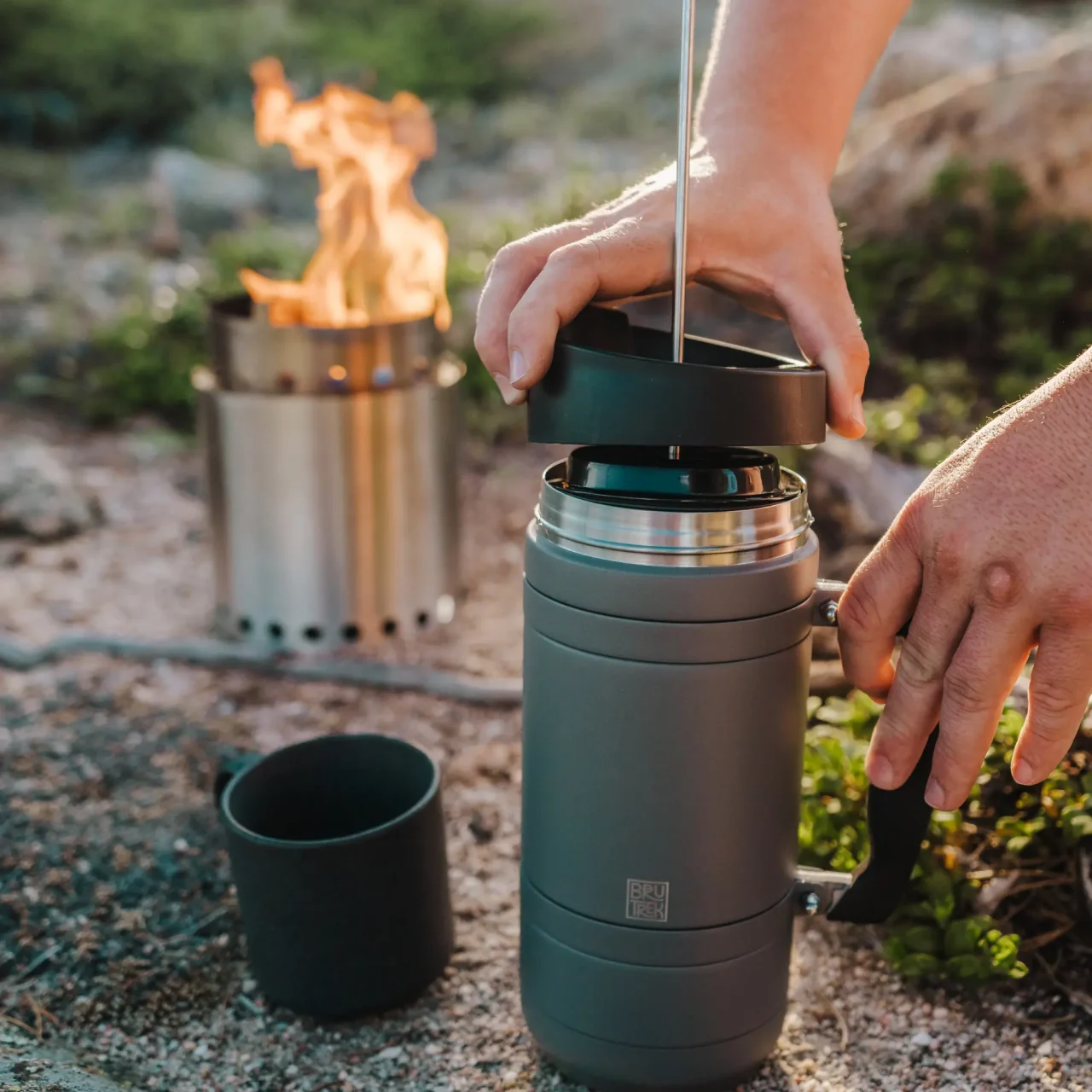
Campfire Coffee Brewing Methods:
III. Immersive Campfire Coffee French Press
French press coffee has captured the hearts of outdoor enthusiasts for its immersive brewing experience and the full-bodied, rich flavor it delivers. The allure of the French press lies in its simplicity and the ability to extract the full range of flavors from the coffee beans. When camping, the French press method allows you to savor a delicious cup of coffee that connects you with nature and elevates your campfire moments.
French press brewing involves steeping coffee grounds in hot water and then separating them by pressing a plunger down, which traps them at the bottom of the pot. This method allows for a longer contact time between the coffee and water, resulting in a full-bodied and robust flavor profile. French press coffee preserves the natural oils and fine particles that paper filters would typically remove, contributing to its rich mouthfeel and deep flavors.
Choosing the Right French Press for Camping:
When selecting a French press for camping, consider the following factors:
1. Material, Size, and Portability:
Look for a French press made of durable materials like stainless steel or BPA-free plastic. Consider the size and weight of the French press, ensuring it’s portable enough to carry on your camping adventures. Options like being carabineer friendly are also great options.
2. Insulated French Presses for Heat Retention:
Insulated French presses are particularly beneficial for camping. They are designed to retain heat, keeping your coffee hot for an extended period, even in the wilderness.
3. Drinkable French Press:
To reduce the number of items to bring to the campsite or on the backpacking trip. Also, you reduce cleaning and water use by not having mugs or cups specifically designed for coffee.
Hey, guess what? We designed our French presses to have these features and more! Take a look at our over-designed Travel French Press.
Brewing Delicious Campfire Coffee with a French Press:
1. Preparing the Right Coffee Grind and Measuring Proportions:
Grind your coffee beans to a coarse consistency, similar to breadcrumbs. Use a burr or manual grinder specifically designed for French press brewing. Measure the coffee-to-water ratio, usually around 1:15 (1 part coffee to 15 parts water), and adjust according to your preferred strength.
2. Achieving the Ideal Brewing Time and Water Temperature:
Heat water to around 200°F (93°C), just below boiling. Pour a small amount of hot water into the French press to preheat it, then discard the water. Add the measured coffee grounds to the French press, followed by hot water. Stir gently to ensure all the grounds are fully saturated.
3. Plunging and Decanting for a Smooth and Flavorful Cup:
Slowly press the plunger down after steeping the coffee for about four minutes. The mesh filter will separate the coffee grounds from the liquid, creating a smooth brew. With traditional French Presses, once the plunger is fully pressed, you must pour the coffee into another vessel to prevent over-extraction. With BruTrek® Travel French Presses and Bru-Stop™ technology, enjoy coffee at your own pace and know it will be just as good from the first sip to the last.
Check Out Our Best French Press Guide
Tips and Personalization with French Press Coffee:
Experiment with the coffee-to-water ratio and brewing time to adjust the strength of your French press coffee. Increase the ratio for a stronger brew or extend the brewing time for a bolder flavor. Personalize your cup by adding milk, cream, or sweeteners to taste.
French press brewing allows you to fully experience the nuances of different coffee beans and roast profiles. Explore various origins, blends, and roast levels for your preferred flavors. Consider trying specialty single-origin coffees for a unique and memorable camping coffee experience.
After use, disassemble the French press and rinse all parts with water to remove the coffee grounds. If possible, dispose of the coffee grounds in an eco-friendly manner. Use a soft brush or sponge to clean the mesh filter and interior surfaces. Be mindful of waste disposal while camping, and minimize the environmental impact of cleaning your French press.
If you want an easy way to clean a French Press, check out our highly rated removable bottom Travel French Press. Oh, and read THIS REVIEW.
French press brewing offers a delightful and immersive coffee experience in the great outdoors. With the right French press and attention to brewing techniques, you can enjoy a robust and flavorful cup of coffee that enhances your camping adventures. Immerse yourself in the simplicity and indulgence of French press coffee, and let it elevate your campfire mornings or serene sunset moments amidst nature.
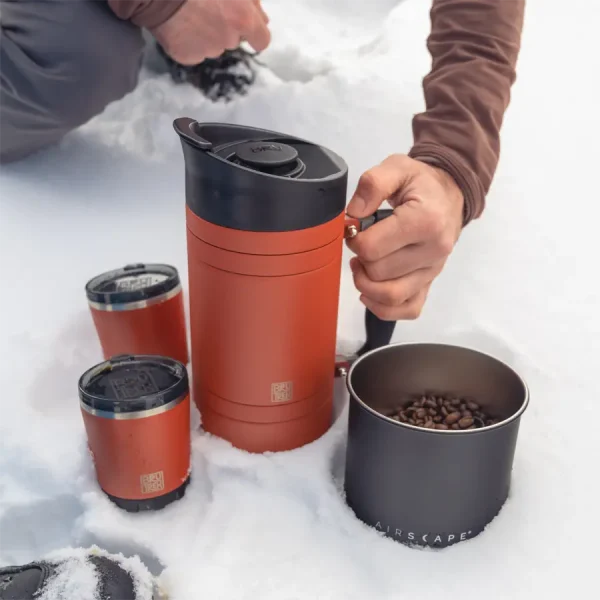
Troubleshooting Common Campfire Coffee Issues:
1. Preventing Coffee Grounds in Your Cup:
To prevent coffee grounds from ending up in your cup while brewing over a campfire, there are a few steps you can take:
– Grind your coffee beans coarsely: Finer grinds tend to slip through the filter. Opting for a coarser grind will help minimize the chances of grounds entering your cup.
– Use a quality coffee filter: Invest in a high-quality, fine-mesh coffee filter specifically designed for campfire brewing. These filters are more effective in trapping smaller coffee particles and preventing them from escaping into your cup.
– Be cautious while pouring: When pouring your brewed coffee from the brewing vessel to your cup, do it slowly and with a steady hand. This helps to avoid disturbing the settled grounds and keeps them at the bottom of the brewing vessel.
– Use one of our French Presses! Yep, we have patented Bru-Stop™ technology. This technology is a one-way valve that allows the water through when pressing and stops the grounds from interacting with the water after. This doesn’t allow grounds into your coffee and halts the brewing process, making sure your coffee keeps fresh.
2. Adjusting Weak or Bitter Campfire Coffee:
– Weak coffee: If your campfire coffee tastes weak, you may need to adjust the coffee-to-water ratio. Increase the number of coffee grounds slightly to achieve a stronger flavor. Additionally, consider extending the brewing time to allow for more extraction.
– Bitter coffee: If your campfire coffee tastes bitter, it may be due to over-extraction (not a problem with the Bru-Stop™ technology). Try reducing the brewing time or using slightly coarser coffee grounds to counter this. Alternatively, adjust the water temperature by using slightly cooler water to avoid over-extraction.
3. Solutions for Brewing in Windy or Rainy Conditions:
– Windy conditions: Wind can significantly affect the heat distribution and brewing process over a campfire. To combat this, create a windbreak by using a camp stove windshield, rocks, or any other available barriers. This helps maintain a steady flame and protects the brewing vessel from gusts of wind.
– Rainy conditions: Brewing coffee during rainy conditions can be challenging. Consider using a camping stove with a built-in windscreen and rain guard to protect the flame. Additionally, set up a rain shelter or use an umbrella to dry yourself and your brewing area. It’s also helpful to have pre-measured ingredients and equipment readily accessible to minimize exposure to rain.
Sustainable and Eco-friendly Practices for Campfire Coffee:
1. Minimizing Waste While Brewing Outdoors:
– Plan your coffee portions: Measure the amount of coffee and water you need to avoid excess brewing. This way, you’ll minimize leftover coffee that may go to waste.
– Reusable brewing equipment: Consider using reusable coffee filters, such as stainless steel or fabric filters, instead of disposable paper filters. These options are eco-friendly and reduce waste.
– Opt for reusable cups and mugs: Instead of using single-use cups, bring your own reusable coffee cups or travel mugs to enjoy your campfire coffee. This eliminates the need for disposable cups and reduces waste.
2. Eco-friendly Coffee Filters and Reusable Options for Camping:
– Stainless steel filters: Stainless steel filters are a sustainable alternative to disposable paper filters. They allow for multiple uses and are easily cleaned.
– Fabric filters: Fabric filters are another eco-friendly option, usually made of cotton or hemp. These filters provide excellent flavor extraction and can be rinsed and reused. This is the type of filter that comes with the Collapsible Pour Over.
– French press: French press brewing eliminates the need for filters altogether, making it a waste-free brewing method. The stainless steel mesh filter in a French press can be cleaned and reused multiple times.
3. Proper Disposal of Coffee Grounds in Nature:
Pack out your coffee grounds: Just like any other waste, it’s essential to pack and dispose of your coffee grounds properly. Store them in a sealed container or bag and dispose of them in a designated waste receptacle when you return from your camping trip.
– Composting: Coffee grounds are rich in nitrogen and can be composted. If you’re camping in an area that allows for composting, you can bury the coffee grounds in a small hole away from water sources, plants, and campsites. For at-home composting, try our 5-gallon bucket insert!
– Follow Leave No Trace principles: Always adhere to Leave No Trace principles when disposing of coffee grounds in nature. Avoid dumping coffee grounds directly on the ground or in bodies of water, as they can disrupt the ecosystem.
By adopting these sustainable practices and being mindful of your impact, you can enjoy your campfire coffee while minimizing waste and preserving your natural environment.
Campfire coffee is more than just a beverage; it’s a way to connect with nature and savor the moment. By mastering the pour-over, percolator, and French press methods, you can enjoy a variety of flavors and brewing experiences during your camping adventures. Experiment with different coffee beans, roast levels, and additives to tailor your campfire coffee to your taste. Remember, the art of outdoor brewing is about embracing the journey and the sensory delights it brings. So, gather around the campfire, ignite your passion for coffee, and let the art of campfire brewing create lasting memories in the wilderness. Cheers to the joy of campfire coffee!
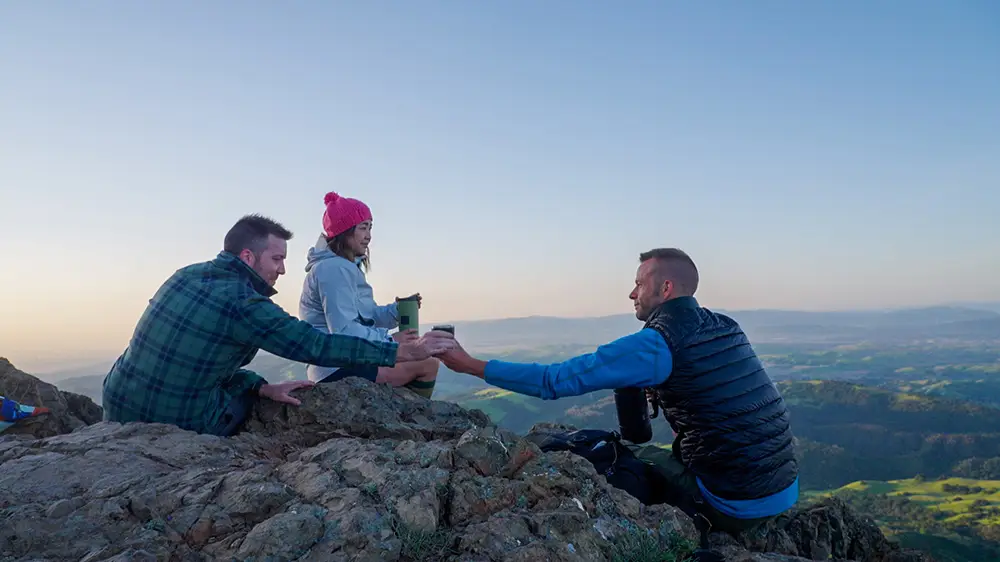
passions pursued & brewed
Customer Support
Contact Us
Terms Of Use
Gift Cards
Shipping & Returns
Warranty
Sustainability Promise
We are at the confluence of coffee and sustainability. Our products are reusable and eliminate the need for single-use items.
Are Your a Coffee Roaster or Retail Shop?
Learn more about our wholesale pricing & custom printing from our in-house sales staff.
Stay In Touch
Be the first to know about new products, special offers, & more.
By entering my email above, I consent to receiving marketing and other promotional emails and consent to the Privacy Policy. I may opt-out at any time.
© 2024 PLANETARY DESIGN. All rights reserved.
